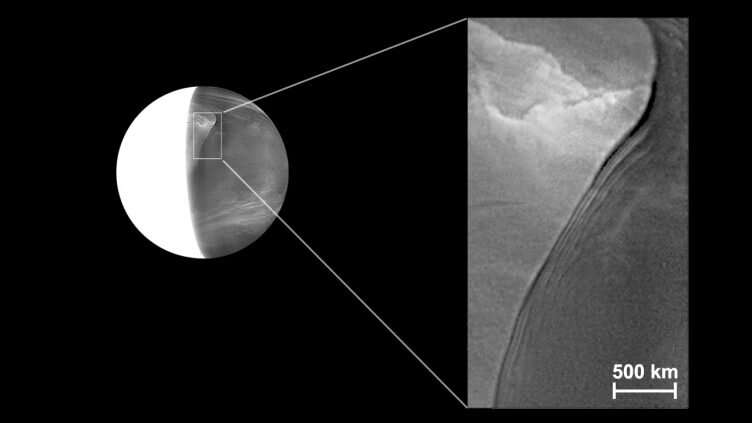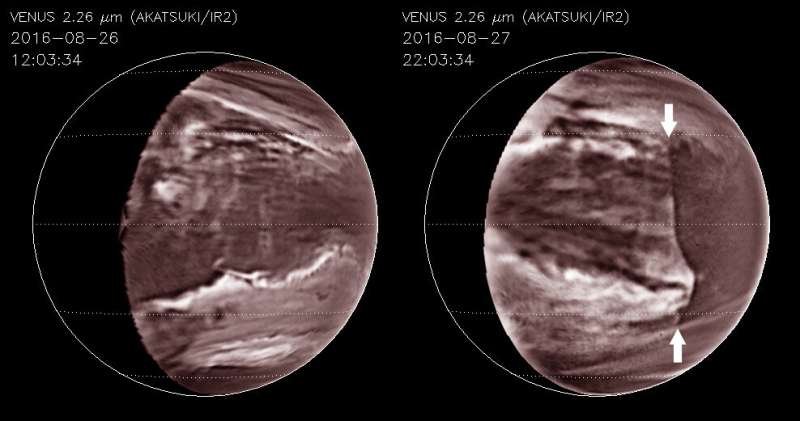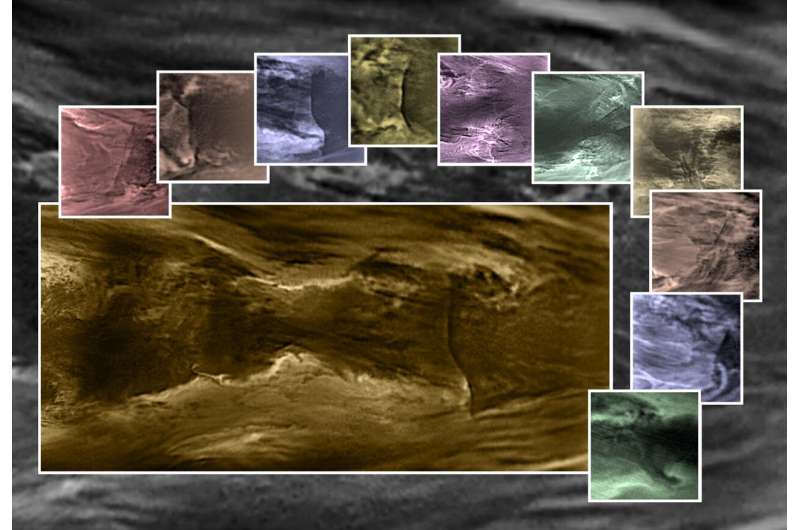Decades-long deep giant cloud disruption discovered on Venus

A planetary-scale cloud discontinuity has been periodically lashing the depths of the thick blanket of clouds on Venus for at least 35 years, says a study with the participation of the Instituto de Astrofísica e Ciências do Espaço (IA).
In the cloudy heavens of Venus, consisting mostly of carbon dioxide with clouds made of droplets of sulphuric acid, a giant atmospheric disruption not yet seen elsewhere in the solar system has been rapidly moving at around 50 kilometers above the hidden surface, and has gone unnoticed for at least 35 years. Its discovery is reported in a study now published in the Geophysical Research Letters and had the contribution of Pedro Machado, of Instituto de Astrofísica e Ciências do Espaço (IA) and Faculdade de Ciências da Universidade de Lisboa (Ciências ULisboa).
This planet-wide cloud discontinuity can sometimes extend as far as 7500 kilometers, across the equator, from 30º north to 40º south, and happens at the lower cloud level, at altitudes between 47.5 and 56.5 kilometers. The researchers discovered that since at least 1983, this wall of acid clouds is periodically swiping the solid globe over five days at about 328 kilometers per hour.
The study was led by the Japanese space agency JAXA, which first spotted what looked like an atmospheric wave, but of planet-sized proportions. This was hinted from the infrared images of great detail taken from the nightside of the planet by JAXA's Venus orbiter Akatsuki, which probed the mid and lower layers of the atmosphere.
"If this happened on Earth, this would be a frontal surface at the scale of the planet, and that's incredible," says Pedro Machado. "Under the follow-up campaign, we went back to images I took in the infrared in 2012 with the Galileo National Telescope (TNG), in Canary Islands, and we found precisely the same disruption."
IA contributed under its long research program studying Venus' winds, but also with follow-up observations with NASA's Infrared Telescope Facility (IRTF), in Hawaii, coordinated with new observations made from space with the Akatsuki orbiter.

While researchers have observed other giant cloud patterns in the atmosphere of Venus, such as the Y wave or the 10,000-kilometers-long, bow-shaped stationary wave in the upper clouds, this is the first serious candidate for a planetary wave found at low altitudes.
The deep region in the atmosphere where this new disruption was discovered is responsible for the rampant greenhouse effect that retains the heat and keeps the surface at a temperature of 465 degrees Celsius, hot enough to melt lead. Planetary-scale waves such as this might help establish a link between the surface and the dynamics of the Venusian atmosphere as a whole, which, to an extent, is still a mystery.

"Since the disruption cannot be observed in the ultraviolet images sensing the top of the clouds at about 70 kilometers height, confirming its wave nature is of critical importance," says Javier Peralta, who led this study. "We would have finally found a wave transporting momentum and energy from the deep atmosphere and dissipating before arriving at the top of the clouds. It would therefore be depositing momentum precisely at the level where we observe the fastest winds of the so-called atmospheric super-rotation of Venus, whose mechanisms have been a long-time mystery."
However, the mechanism that ignited and maintains the long-lasting phenomenon with cycles of varying intensity is still unknown, despite computer simulations trying to mimic it. According to the researchers, this atmospheric disruption is a new meteorological phenomenon, unseen on other planets, and it is thus difficult to provide a confident physical interpretation.
While it will be the focus of future research, the authors suggest that this disruption may be the physical manifestation of an atmospheric wave of the Kelvin type, propagating and trapped about the equator. Kelvin waves are a class of atmospheric gravity waves that share important common features with this disruption. For instance, they propagate in the same direction as the super-rotating winds and with no apparent effect on the meridional winds, the winds blowing from the equator toward the poles.
Kelvin waves can interact with other types of atmospheric waves like the ones that naturally occur as a result of the rotation of the planet, the Rossby waves. These may cause the transport of energy of the super-rotation to the equator.
Revisiting images taken as far back as 1983, the researchers were able to confirm the presence of the same features. According to Pedro Machado, it was unnoticed for so long because "we needed access to a large, growing and scattered collection of images of Venus gathered in the recent decades with different telescopes."
More information: J. Peralta et al. A Long‐Lived Sharp Disruption on the Lower Clouds of Venus, Geophysical Research Letters (2020). DOI: 10.1029/2020GL087221
Journal information: Geophysical Research Letters
Provided by Instituto de Astrofísica e Ciências do Espaço





















